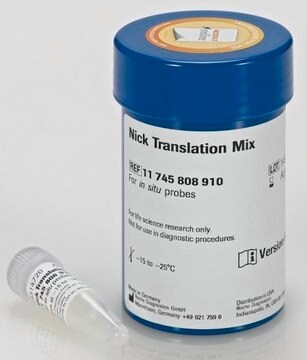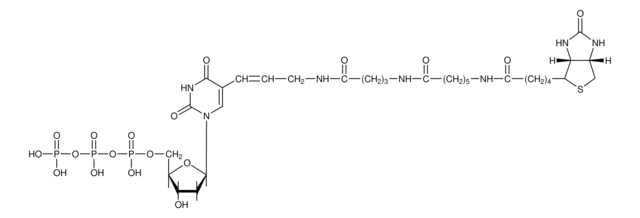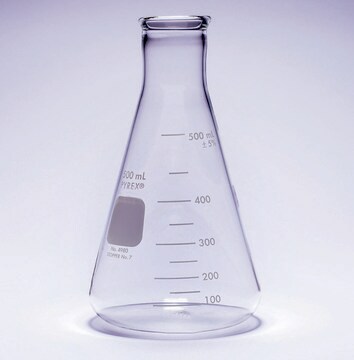10976776001
Roche
Nick Translation Kit
sufficient for 50 labeling reactions, kit of 1 (7 components), suitable for FISH
Sinonimo/i:
nick translation
Autenticatiper visualizzare i prezzi riservati alla tua organizzazione & contrattuali
About This Item
Codice UNSPSC:
41105500
Prodotti consigliati
impiego
sufficient for 50 labeling reactions
Livello qualitativo
Confezionamento
kit of 1 (7 components)
Produttore/marchio commerciale
Roche
tecniche
FISH: suitable
Temperatura di conservazione
−20°C
Descrizione generale
Kit for radioactive or nonradioactive labeling of DNA by the nick translation method. This method utilizes a combination of DNase and DNA Polymerase to nick one strand of the DNA helix, then incorporates labeled nucleotides as the polymerase examines, or "proofreads" the nicked site.
Specificità
Heat inactivation: Stop the reaction by adding 1μl 0.5 M EDTA (pH 8.0) and/or by heating to 65 °C for 10 minutes.
Applicazioni
Nick translation kit has been used in FISH (fluorescence in situ hybridization) based labeling of tick and bacterial artificial chromosome. It has been used in labeling the probe (genomic DNA) in order to obtain GISH (genomic in situ hybridization) signals.
The kit is used for labeling of DNA with radioactive or modified dNTPs. Probes labeled by nick translation are used in many different hybridization techniques. These include use as probes in:
- Screening gene banks by colony- or plaque hybridization
- DNA or RNA transfer hybridizations
- In situ hybridization
- Reassociation kinetic studies
Confezionamento
1 kit containing 7 components.
Specifiche
Assay Time: 45minutes
Specific Activity: The level of specific labeling and the incorporation rate are dependent on the ratio of substrate DNA to labeled deoxyribonucleoside triphosphate, e.g., the kinetics and labeling levels obtained are identical in assays containing 0.1μg DNA and 20μCi dXTP or 0.5μg DNA and 100μCi dXTP.
The standard assay will give a specific activity of 3 x 108 dpm/μg, corresponding to 65% incorporation with different substrate DNAs (e.g., pBR322, λDNA, DNA fragments) in 35minutes.
Sample Materials
Specific Activity: The level of specific labeling and the incorporation rate are dependent on the ratio of substrate DNA to labeled deoxyribonucleoside triphosphate, e.g., the kinetics and labeling levels obtained are identical in assays containing 0.1μg DNA and 20μCi dXTP or 0.5μg DNA and 100μCi dXTP.
The standard assay will give a specific activity of 3 x 108 dpm/μg, corresponding to 65% incorporation with different substrate DNAs (e.g., pBR322, λDNA, DNA fragments) in 35minutes.
Sample Materials
- Supercoiled and linearized plasmid DNA
- Supercoiled and linearized cosmid DNA
- BAC DNA or human genomic DNA
- Purified PCR products
Principio
The nick translation method is based on the ability of DNase I to introduce randomly distributed nicks into DNA at low enzyme concentrations in the presence of Mg2+. E. coli DNA polymerase I synthesizes DNA complementary to the intact strand in a 5′→3′ direction using the 3′-OH termini of the nick as a primer. The 5′→3′ exonucleolytic activity of DNA polymerase I simultaneously removes nucleotides in the direction of synthesis. The polymerase activity sequentially replaces the removed nucleotides with isotope-labeled or hapten-labeled deoxyribonucleoside triphosphates. At low temperature (+15°C), the unlabeled DNA in the reaction is thus replaced by newly synthesized labeled DNA.
Nota sulla preparazione
Working concentration: The recommended working concentration with T7, T3 or SP6 RNA Polymerases is 1 mM.
Working solution: DNA
The DNA must be in low-salt concentration solution.
dATP, dGTP, dTTP
Working solution: DNA
The DNA must be in low-salt concentration solution.
dATP, dGTP, dTTP
- If the same labeled deoxyribonucleoside triphosphate is used repeatedly, we recommend the preparation of a mixture of equal parts of the other three triphosphates for convenience.
- Prepare the dATP, dGTP, dTTP mixture by making a 1:1:1 mixture of solution 2, solution 4, and solution 5.
Altre note
For life science research only. Not for use in diagnostic procedures.
Solo come componenti del kit
N° Catalogo
Descrizione
- Control DNA pBR322, 20 μl 50 µg/ml
- dATP, 50 μl 0.4 mM
- dCTP, 50 μl 0.4 mM
- dGTP, 50 μl 0.4 mM
- dTTP, 50 μl 0.4 mM
- Nick Translation Buffer, 100 μl 10x concentrated
- Enzyme Mixture, 100 μl, DNA Polymerase I and DNase I in 50% glycerol (v/v)
Codice della classe di stoccaggio
12 - Non Combustible Liquids
Classe di pericolosità dell'acqua (WGK)
WGK 1
Punto d’infiammabilità (°F)
does not flash
Punto d’infiammabilità (°C)
does not flash
Scegli una delle versioni più recenti:
Possiedi già questo prodotto?
I documenti relativi ai prodotti acquistati recentemente sono disponibili nell’Archivio dei documenti.
I clienti hanno visto anche
Amy Sebeson et al.
PloS one, 10(5), e0127214-e0127214 (2015-05-21)
The binding sequence for any transcription factor can be found millions of times within a genome, yet only a small fraction of these sequences encode functional transcription factor binding sites. One of the reasons for this dichotomy is that many
A methylation status analysis of the apomixis-specific region in Paspalum spp. suggests an epigenetic control of parthenogenesis.
Podio M, et al.
Journal of Experimental Botany, 65(22), 6411-6424 (2014)
David U Gorkin et al.
Genome biology, 20(1), 255-255 (2019-11-30)
The 3-dimensional (3D) conformation of chromatin inside the nucleus is integral to a variety of nuclear processes including transcriptional regulation, DNA replication, and DNA damage repair. Aberrations in 3D chromatin conformation have been implicated in developmental abnormalities and cancer. Despite
Aiko Iwata-Otsubo et al.
Current biology : CB, 27(15), 2365-2373 (2017-08-02)
Female meiosis provides an opportunity for selfish genetic elements to violate Mendel's law of segregation by increasing the chance of segregating to the egg [1]. Centromeres and other repetitive sequences can drive in meiosis by cheating the segregation process [2]
Anna Zaleśna et al.
Comparative cytogenetics, 11(2), 249-266 (2017-09-19)
We studied water frogs from a complex composed of two species: Pelophylax lessonae (Camerano, 1882) (genome LL, 2n = 26) and P. ridibundus (Pallas, 1771) (RR, 2 = 26), and their natural hybrid P. esculentus (Fitzinger, 1843) of various ploidy
Il team dei nostri ricercatori vanta grande esperienza in tutte le aree della ricerca quali Life Science, scienza dei materiali, sintesi chimica, cromatografia, discipline analitiche, ecc..
Contatta l'Assistenza Tecnica.







